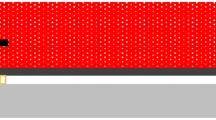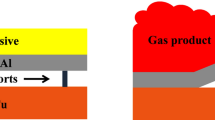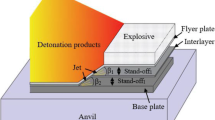Abstract
Molybdenum–copper composites were developed as heat sink materials. In order to reduce the amount of molybdenum used in the composite material, the explosive welding of molybdenum foil to copper plate was studied. Through the analysis of microstructure and elements, ideas for the processing of molybdenum–copper heat sink materials were proposed. The embrittlement of the molybdenum foil could be reduced by using salt as protective layer. The thickness increase in explosive in the weldability window results in more molybdenum melting, which reduces the generation of microcracks in return. The welding strength in the wave waist is lower than that in the wave front, and the thermal stress exceeding the strength limit of the molybdenum foil may be the important reason for the formation of microcracks. Delamination cracks in the isotherm direction and interface cracks in the joint direction can be observed. Methods of reducing temperature gradients such as thermal explosive welding can reduce the occurrence of microcracks. From outside the vortex to the center of the vortex, the copper content gradually decreases, while the molybdenum content gradually increases. The formation of the vortex is mainly dependent on the movement of copper. The molybdenum element in the transition layer is mainly introduced by diffusion process. The melting of molybdenum particles will lead to uneven quality distribution of molybdenum in the vortex. Compared with the copper side, the molybdenum side at the same distance from interface has a higher work hardening.







Similar content being viewed by others
References
Kalbasi R, Introducing a novel heat sink comprising PCM and air - Adapted to electronic device thermal management, Int. J. Heat Mass Transfer, 169 (2021) 120914. https://doi.org/10.1016/j.ijheatmasstransfer.2021.120914
Marri GK & Balaji C, Experimental and numerical investigations on the effect of porosity and PPI gradients of metal foams on the thermal performance of a composite phase change material heat sink, Int. J. Heat Mass Transfer, 164 (2021) 120454. https://doi.org/10.1016/j.ijheatmasstransfer.2020.120454
Bianco N, Iasiello M, Mauro GM & Pagano L, Multi-objective optimization of finned metal foam heat sinks: Tradeoff between heat transfer and pressure drop, Appl. Therm. Eng., 182 (2021) 116058. https://doi.org/10.1016/j.applthermaleng.2020.116058
Zhang J, Xiao Y, Luo G, Shen Q & Zhang L, Effect of Ni interlayer on strength and microstructure of diffusion-bonded Mo/Cu joints, Mater. Lett., 66 (2012) 113-116. https://doi.org/10.1016/j.matlet.2011.08.077
Parchuri PK, Kotegawa S, Ito K, Yamamoto H … & Hokamoto K, Characterization of shock wave damages in explosion welded Mo/Cu clads, Metals, 11 (2021) 501. https://doi.org/10.3390/met11030501
Yano S, Matsui H & Morozumi S, Structural observations of the interface of explosion-bonded Mo/Cu system, J. Mater. Sci., 33 (1998) 4557-4865. https://doi.org/10.1023/A:1004438515248
Naveen Kumar N, Janaki Ram GD, Bhattacharya SS, Dey HC & Albert SK, Spark plasma welding of austenitic stainless steel AISI 304L to commercially pure titanium, Trans. Indian Inst. Met., 68 (2015) 289-297. https://doi.org/10.1007/s12666-015-0589-6
Sherpa BB, Kumar PD, Upadhyay A, Kumar S & Tyagi S, Neuro-fuzzy technique for micro-hardness evaluation of explosive welded joints, Trans. Indian Inst. Met., 73 (2020) 1287-1299. https://doi.org/10.1007/s12666-020-01980-2
Sherpa BB, Kumar PD, Upadhyay A, Kumar S, Tyagi S, Trans Indian Inst Met 74 (2021) p 511.
Zhang J, Shen Q, Luo G, Li M & Zhang L, Microstructure and bonding strength of diffusion welding of Mo/Cu joints with Ni interlayer, Mater. Des., 39 (2012) 81-86. https://doi.org/10.1016/j.matdes.2012.02.032
Wang D, Chen D, Yang Y & Sun A, Interface of Mo–Cu laminated composites by solid-state bonding, Int. J. Refract. Met. Hard Mater., 51 (2015) 239-242. https://doi.org/10.1016/j.ijrmhm.2015.04.019
Wang X, Tang H, Shao M, Jin H & Liu H, Laser impact welding: Investigation on microstructure and mechanical properties of molybdenum-copper welding joint, Int. J. Refract. Met. Hard Mater., 80 (2019) 1-10. https://doi.org/10.1016/j.ijrmhm.2018.12.016
Liu K, Chen P, Feng J, Ran C … & Zhu L, Fabrication and characterization of the Mo/Cu bimetal with thick Mo layer and high interfacial strength, Int. J. Refract. Met. Hard Mater., 94 (2021) 105383. https://doi.org/10.1016/j.ijrmhm.2020.105383
Hokamoto K, Nakata K, Mori A, Tsuda S, Inoue A, J Alloys Compd, 472 (2009) p 507. https://doi.org/10.1016/j.jallcom.2008.05.002.
Yang M, Ma H, Shen Z, Huang Z, Tian J, Mater Des, 186 (2020) p 108348. https://doi.org/10.1016/j.matdes.2019.108348
Liu WD, Liu K, Chen Q, Wang J, Li X, Appl Surf Sci, 255 (2009) p 9343. https://doi.org/10.1016/j.apsusc.2009.07.033
Zhou Q, Feng J & Chen P, Numerical and experimental studies on the explosive welding of tungsten foil to copper, Materials, 10 (2017) 984. https://doi.org/10.3390/ma10090984
Bi Z, Li X, Wu Y, Wang Q … & Rong K, Study on explosion welding of T2/Q345 alloys with self‑restraint explosive, Chin. J. Energ. Mater. 5 (2021) 394-398. https://doi.org/10.11943/CJEM2021028
Bi Z, Li X, Yang K, Rong K, Wu Y, Def Technol, (2022) Doi: https://doi.org/10.1016/j.dt.2022.05.001
Yang M, Xu J, Ma H, Lei M … & Jie T, Microstructure development during explosive welding of metal foil: morphologies, mechanical behaviors and mechanisms, Composites, Part B, 212 (2021) 108685. https://doi.org/10.1016/j.compositesb.2021.108685
Wilson MP & Brunton JH, Wave formation between impacting liquids in explosive welding and erosion, Nature, 226 (1970) 538-541. https://doi.org/10.1038/226538b0
Upadhyay A, Sherpa BB, Kumar S, Kumar PD, Agarwal A, Trans Indian Inst Met, 72 (2019) p 1521. https://doi.org/10.1007/s12666-019-01603-5
Acknowledgements
This research was sponsored by National Natural Science Foundation of China [Grant Number 11872002], Natural Science Foundation of Anhui Province [1808085QA06], and Postdoctoral Foundation of Anhui Province [2019B355].
Author information
Authors and Affiliations
Corresponding author
Additional information
Publisher's Note
Springer Nature remains neutral with regard to jurisdictional claims in published maps and institutional affiliations.
Rights and permissions
Springer Nature or its licensor (e.g. a society or other partner) holds exclusive rights to this article under a publishing agreement with the author(s) or other rightsholder(s); author self-archiving of the accepted manuscript version of this article is solely governed by the terms of such publishing agreement and applicable law.
About this article
Cite this article
Bi, Z., Li, X., Rong, K. et al. Study on the Interface of Molybdenum Foil-copper Explosive-welded Composite Plate. Trans Indian Inst Met 76, 1677–1684 (2023). https://doi.org/10.1007/s12666-022-02737-9
Received:
Accepted:
Published:
Issue Date:
DOI: https://doi.org/10.1007/s12666-022-02737-9




